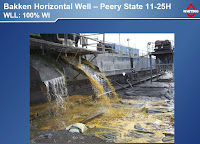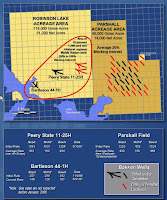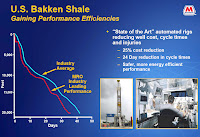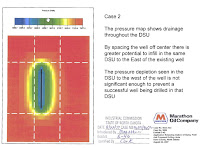In what should be the most spirited hearing since, well, last month, Marathon is attempting to flex its muscle with Encore at the upcoming September hearing regarding the Murphy Creek field area in central Dunn Co. As indicated in my recent post about well density, Marathon had requested that this field's boundaries be expanded and asked that about eighteen 1280 acre spacing units be created. Marathon had previously received permission to create three 1280 acre drilling units in secs. 4 and 9 and 5 and 8, T144, R96 and secs. 27 and 34, T145, R. 96. The company has just finished drilling the well on secs. 5 and 8, and has just spudded the well on secs. 4 and 9.
Encore as predecessor to Kerr McGee had been developing the field on 640 acre units, and is currently drilling a 640 acre unit in sec. 1, T144, R96. After Marathon applied for the 1280s last month, Encore suddenly applied for and received about a half dozen drilling permits for 640 acre units. At the hearing last month, Marathon stated that they reached agreement with Encore that Encore would develop about half the requested sections on 640 acre units, and Marathon would drop those sections from its request.
Well, that agreement must not have suited someone, because Marathon is now requesting that most of the lands that it dropped from its original request last month in favor of Encore be once again be made into 1280 spacing units, or drilling units in the alternative. It should be noted that in a number of these proposed 1280s, Encore appears to have half interest in the unit. What should be the most contentious portion of this hearing is Marathon's separate and related request that most of the drilling permits Encore received (and has not yet drilled) be suspended and/or revoked. Like I said before, its time for the IC to issue some uniform guidelines as to this density issue, especially when it pertains to the same field, and where some development has already occurred on 640 acre units, which are legal units created with only the granting of a drilling permit.
In a related development, the activity in this area appears to be headed west as Tracker Res. has applied for a 1280 acre drilling unit a few miles to the west on the eastern edge of Little Knife Field in secs. 4 and 9, T144, R97. Tracker is currently drilling a rank wildcat about 20 miles to the east in secs. 1 and 12, T.144, R.94.
Map Legend:
red/orange: Marathon's new 1280 acre requested units
blue/light green: Marathon's 1280 acre units requested last month after dropping Encore's acreage
gray: Marathon's established 1280 acre drilling units
dark green: Tracker's new 1280 acre drilling unit request
yellow: mostly Encore's 640 acre units (in the center of the field area) already drilled



















































